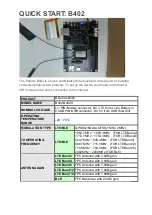
3.3.11 Controlling H-Bridge LLC Resonant Converter
For many years, various topologies of resonant converters have been well-known in the field of power
electronics. In addition to these, H-bridge LLC resonant converter topology has recently gained popularity
in many consumer electronics applications where high efficiency and power density are required. In this
example, the single channel configuration of ePWM1 is detailed, yet the configuration can easily be extended to
multichannel. Here, the controlled parameter is not duty cycle (this is kept constant at approximately 50 percent);
instead it is frequency. Although the deadband is not controlled and kept constant as 300ns (that is, 18@60MHz
TBCLK), it is up to the user to update it in real time to enhance the efficiency by adjusting enough time delay for
soft switching.
V
DC_bus
V
OUT
EPWM1A
EPWM1B
Cr
Integrated
Magnetcis
LLC Resonant
Transformer
En
SyncIn
SyncOut
CNT=Zero
CNT=CMPB
X
!"#"
X
Phase Reg
Master
1
Ext Sync In
(optional)
EPWM1A
EPWM1B
NOTE:
Θ
= X indicates value in phase register is a
"don't care"
Figure 3-70. Control of Two Resonant Converter Stages
CA
CB
A
P
P
CA
CB
A
P
RED
FED
EPWMxA
EPWMxB
P
I
P
I
P
I
ZVS
transition
ZVS
transition
period/2
period
period/4
P
I
Indicates this event triggers an interrupt
CB
A
Indicates this event triggers an ADC
start of conversion
Figure 3-71. H-Bridge LLC Resonant Converter PWM Waveforms
Enhanced Pulse Width Modulator (ePWM) Module
326
TMS320x2806x Microcontrollers
SPRUH18I – JANUARY 2011 – REVISED JUNE 2022
Copyright © 2022 Texas Instruments Incorporated
Summary of Contents for TMS320 2806 Series
Page 2: ......
















































